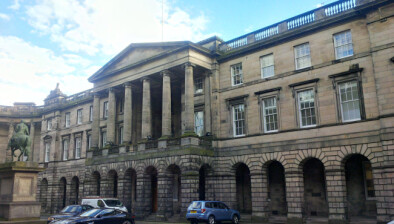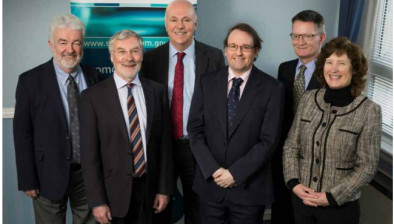Review: Remembrance of things past
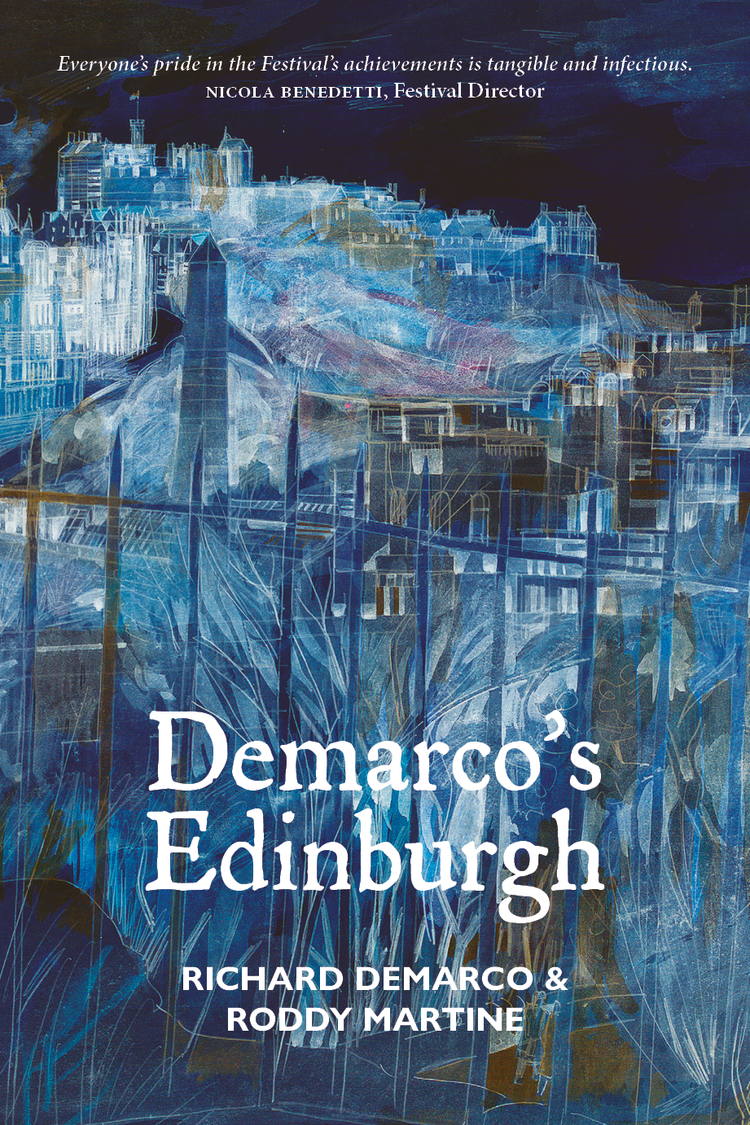
David J Black recalls a bygone era in Demarco’s Edinburgh.
Two years after the end of a devastating European conflict, Edinburgh found its place in the emerging new world, its civic redemption triggered by an international festival. It would never look back. Much of this initiative may be credited to a far-sighted Lord Provost, Sir John Falconer (grandfather of future Lord Chancellor Charlie) and its brilliant first director, Sir Rudolf Bing.
The city was largely unaffected by the depredations of war, possibly because the German high command had envisioned it as a future ‘summer capital’ which would be more useful intact, though the Forth Bridge was considered a strategic target. A young Scots-Italian boy, as it happens, was on Portobello beach during a dogfight between a Spitfire and a Messerschmitt when the sand around him was strafed with bullets. His name was Richard Demarco. After that close call he would go on to become a legend who enjoyed (the word is used wilfully) many narrow squeaks until, at the age of 93, he would write it down in his own inimitable way in Demarco’s Edinburgh.
Well into the 1950s our grey, hodden doon Scottish capital retained the sullen characteristics of a bleak county town which had, in the words of R.L Stevenson in Jekyll and Hyde, once been of better account. Its glorious Georgian architecture, black with centuries of soot, seemed like a silent witness to the broken promise of its 18th century enlightenment, when Voltaire had declared “We look to Scotland for all our ideas of civilisation.” Back then the teeming masses of the medieval Old Town had been cleft in twain, the haute bourgeoisie and merchant classes removing themselves to the salubrious precincts of George Square and the Augustan New Town, leaving the fetid closes and wynds around the Royal Mile to slummery and decay.
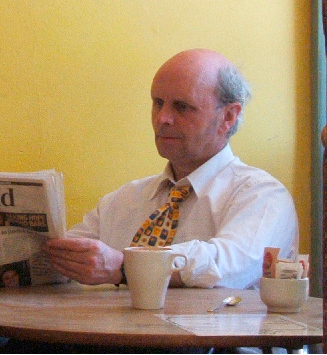
David J Black
The early 1950s Edinburgh of Norman McCaig’s Early Sunday Morning differed little from the First War city of Wilfred Owen’s Six O’Clock in Princes Street or of Muriel Spark’s The Prime of Miss Jean Brodie. In a city Hugh MacDiarmid labelled “a mad god’s dream” the past dominated the present, though change was on the way. Insofar as Edinburgh had a gentry it was largely a staid legal gentry, with a few august exceptions such as Lady Roseberry and Lord Balfour of Burliegh.
In August 1947, everything changed. The aim was “to provide a platform for the flowering of the human spirit” and that first festival, which had the great contralto Kathleen Ferrier and her mentor, the conductor Bruno Walter, on the bill, was transformative.
It was not entirely unprecedented, however. The city had even had a ‘Festival Theatre’ in the 1930s in the building on Elm Row which, in 1946, would become better known as The Gateway Theatre. Its director from 1960, the actor and dedicated controversialist Moultrie Kelsall, once unequivocally informed your scrivener that his theatre, with its primary focus on Scottish writing by the likes of Robert Kemp and James Bridie, was the real moving spirit behind the international festival, and, had it not existed, the Festival would in all likelihood have ended up in Oxford. Certainly, it was the Gateway Company which made possible one of the most memorable early hits of the Festival, Tyrone Guthrie’s 1948 production of Ane satyre of the Thrie Estaitis. While the theatre closed in 1965 the Gateway Company kept going, staging such memorable productions as Luigi Pirandello’s The Man with a Flower in his Mouth, directed by Brian Cox, and starring Fulton Mackay.
The Gateway would seem to have played no great part in Richard Demarco’s life, yet his book is not your average autobiography, nor would any who know the man expect it to be. It falls somewhere between his own Proustian sentimental odyssey for a lost avant garde past and the angry 1909 modernist manifesto of Tommaso Marinetti, a case of À la recherche du temps perdu meets The Declaration of Futurism. Demarco’s Edinburgh might, one suspects, have ended up as a shapeless portmanteau of his own quirky, if fascinating, lived-experience memories (one learns, for example, that his Scotus Academy classroom had been Lord Boothby’s birthplace) but for the co-authorship of former Scottish Field editor Roddy Martine, who no-doubt helped to tone down its excesses and infuse some structural discipline. Mr Martine also provides a handy parallel narrative based on his own next-generation festival experiences.
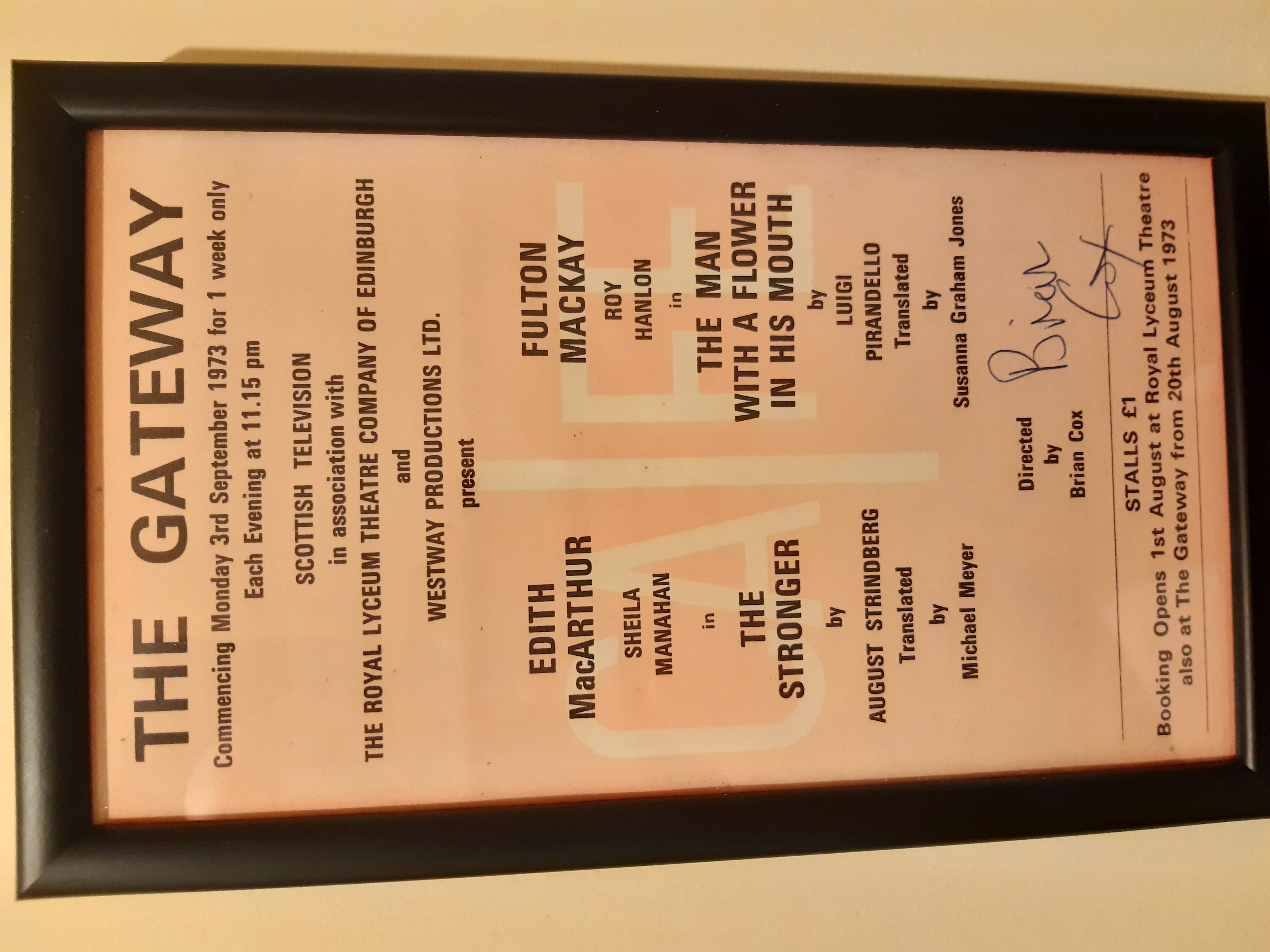
A poster from the Gateway, 1973, signed by Brian Cox. Author's collection.
Between them, they have produced a rare historic document which will for evermore preserve something of the atmosphere of a cultural golden age in which our often censorious city fathers (or, in the case of Councillor Moira Knox, a stern and disapproving mother) sought, like Canute, to hold back the tide of sexual permissiveness.
For a city which cherished its upright reputation there were a few ripe scandals, by no means all of them taking place in the Traverse. An image which didn’t make it into the book is the one of an irate Edinburgh lady, Agnes Cooper, outside Jim Haynes’ Paperback bookshop burning a copy of Lady Chatterley’s Lover, then the subject of a court action under the Obscene Publications Act, to the evident amusement of the proprietor and a few bystanders.
There was an all pervading obsession with morality and decorum in the Festival’s early years, culminating in the appearance of decorously nude model Anna Kesselaar at the linked 1963 Drama Conference. She was paid a fee of £4 by Mr Demarco. This led to several pulpit denunciations, the sacking of Ms Kesselaar from her job as an architect, and the resignation of Festival director Lord Harewood, though the latter was already doomed for having a child – in the parlance of the time – “by a lady other than his wife”. There were surprises all round. Lord Provost Duncan Weatherstone, who was advised to sell his gold chain after asking The Beatles for £100,000 to help fund the Festival, stunned many of his sober-minded colleagues when, aged 70, he married a lady in her 20s.
Indeed, the council’s guardians of municipal rectitude could be performers in their own way. After describing the experience of being confronted by one lady performer removing her top as “like being blinded by headlamps” councillor John D Kidd would become the scourge of the Traverse, co-founded by Richard Demarco, Jim Haynes, and publisher John Calder, with outside encouragement (and some internal fireworks) from theatre critic Kenneth Tynan. When the club’s licence came up for renewal, despite the city fire master and the chief constable recommending refusal on the not unreasonable grounds that the Lawnmarket premises posed a safety risk, Kidd, an implacable enemy of cultural licentiousness, moved for approval. This writer’s late mother was a fellow member of the council’s licensing committee and she asked him about this uncharacteristic volte-face over an institution he ostensibly detested. “Let them burn” was his laconic response.
Richard Demarco’s first Edinburgh gallery occupied a small room in the Lawnmarket’s Traverse Theatre, and one of its first exhibitions featured caricatures sketched on film lots by a man better known as a the star of Ben Hur, Charlton Heston. To your scrivener he seemed most gracious and courteous - this was, of course, long before he was president of the National Rifle Association!
Mr Heston doesn’t make it into the book, but then nor do many other things, like the Craigmillar Festival Society, a community celebration of the arts in which the impresario who baulked at being described as an impresario played a commendably supportive role. The problem is that, as with the herding of cats, there are just too many of them to create an orderly landscape, and with irresistible line-drops like “the bulky figure of J.B Priestley sitting happily in my little white mini discussing the merits of D.H Lawrence with Lillian Hellman” the reader quickly becomes aware that this dynamo of a man who has been to every Edinburgh Festival since the first one is a repository of a superabundance of anecdotes, supplemented, moreover, by Roddy Martine’s colourful recollections.
Some make it in; others don’t. There is much on his friend Sean Connery, and reference to Marlene Dietrich, who your writer recalls dining in the Traverse restaurant with David Frost, as well as her Serene Highness Princess Grace Kelly, who spent her time in Edinburgh swanning around on director John Drummond’s arm and who, quips Roddy Martine, “could have been reading the telephone directory and the audience would still have adored her”. True, your scrivener was there, duly mesmerised, and can’t recall a word of her poetry selection!
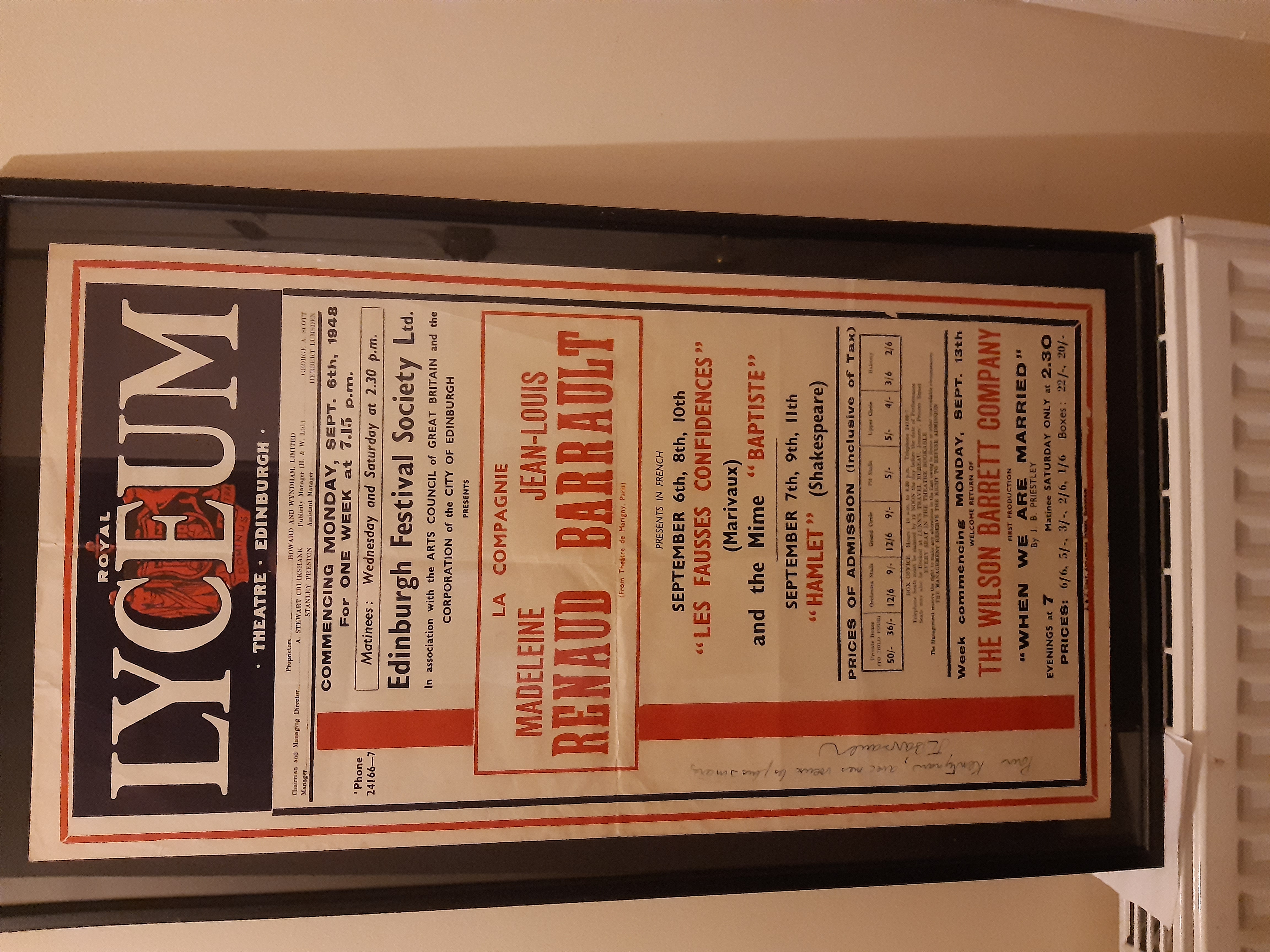
This 1948 Lyceum Theatre poster is inscribed "pour Ken Tynan" from Jean-Louis Barrault. Author's collection.
Mr Demarco, a European to the core, harbours an aversion to American cultural imperialism, in general, though many Americans – like Jim Haynes and Traverse director Michael Rudman - son of a Texas oil tycoon, no less – would change and broaden the character of the festival from the mid 60s onwards. The underlying thesis, at least of the Demarco section of the book, is that the official Festival should be seen as, above all, a European cultural reconstruction project based on the dissemination of the arts, rather than on politics or social planning.
The Traverse, as its extraordinary afterthought, would to a great extent carry this mission forward, but by the mid 60s the dynamic had changed. Founded in 1963, by 1966 it had staged 110 productions, many of them world premieres, but by then a new kind of revolution was replacing the post war appetite for harmony between nations, and its progenitors, increasingly, included the likes of Lindsay Kemp and his rising protege David Bowie, The Scaffold, and poet and dramatist Heathcote Williams, and The Incredible String Band, who were packing them in at the Crown Bar.
By 1984 the ‘official’ Festival, while it never lost a focus on classical music, would prosper under a new kind of director, Frank Dunlop. He followed a deeply disillusioned John Drummond, who would go on to excoriate the philistinism of Edinburgh Council in his memoirs Tainted by Experience. Mr Dunlop fared little better. His exit after eight years of turbulent dealings with councillors who apparently regarded “cultural elitism” with suspicion, marked the end of the Festival’s great days, according to Mr Demarco. The irony of this was that it was Frank Dunlop, of all people, who championed accessibility in the arts, re-invigorated the Festival programme’s Scottish content and was very much a “people’s director” who would go on to fame and fortune with Camelot and Richard Burton in New York. Mr Demarco’s view of the matter, as expressed by his co-author, was a sullen one.
“Frank’s departure from the Festival in 1991 meant that for the following 15 years creative budgets were curtailed to the point of strangulation while stand-up comedy on the Fringe increased to bursting point. Overnight, everybody was a comedian.”
Was that the moment at which the Edinburgh Festival lost its cultural soul, and with it, its raison d’être? The point is arguable, but few would deny that, swamped as it now is by commodification and uncurated stand-up, much of it truly awful, its lack of a sense of direction was reflected in its last nervous clarion call Where do we go from here. The Summerhall arts complex is a hold-out for the old values, and some have discerned a glint of hope in the inspired appointment of violinist Nicola Benedetti as current Festival director, but her executive arm, Francesca Hegyi, was harbouring no illusions when she warned that unless those in authority get their financial act together the Edinburgh International Festival could cease to exist in about 18 months. She isn’t making this up. Edinburgh has one of the most underfunded major cultural festivals in the world, yet its municipal coffers and local businesses take in revenues of almost half a billion pounds per annum from the city’s festivals, a sum which more than doubles thanks to the ripple effect throughout Scotland. One can understand why the left-wing economist John Maynard Keynes was such an enthusiastic early supporter.
One can equally understand why Richard Demarco despairs at the reinvention of our Airbnb tattered city as a comedic catwalk. Lord Provost Duncan Weatherstone had threatened to pull funding when the American master of stand-up profanity, Lenny Bruce, was booked for a Fringe show. No doubt it’s one point upon which he and Mr Demarco would have agreed. Others take the view that not all comedy is culturally destructive – it’s the relentless commercialisation that’s doing the damage.
True, the official cultural sector doesn’t always get it right. Why on earth, one might ask, did government agency Creative Scotland gift a no-strings-attached award of £500,000 to the Sony Corporation in California to subsidise its millionaire movie director Danny Boyle, creator of Trainspotting 2, a drug-glamourising film which denigrates and insults young working-class people on Edinburgh council estates? This was in the very year that the arts body’s grant-in-aid budget was slashed, to the great displeasure of (generally low-earning) working artists, musicians, writers, and performers, who had already endured the indignity of seeing £5m awarded to the Dundee V&A project, on top of the Scottish government’s £15m.
Certainly, there is no love lost between Richard Demarco and the state’s fund-disturbing arts quangos, though he was never quite as iconoclastic as the late Ian Hamilton Finlay, who used to send the officials in their ivory towers pointedly crisp comments on the back of postcards of David’s famous picture illustrating the French radical Jean-Paul Marat murdered in his bath, or St Andrew’s House surmounted by a swastika and eagle. Bombast, of course, but furious bombast.
Demarco’s Edinburgh is a wonderfully flawed book, and it would have been disappointing if it hadn’t been. Those barely navigable long lists of European artists and performers whose names will mean nothing to anyone under the age of 60 should clearly have been corralled in an appendix. Yet the man is the story, and the story is the man. As a tale of resilience, cussed awkwardness, wild imagination, sheer chutzpah, nervous agitation, flashes of mischievous devilment, soaring highs and plummeting lows, affection, annoyance, and sheer bloody-mindedness, it would be hard to beat.
There are several well chronicled accounts of the Edinburgh International Festival and its variants, such as George Bruce’s Festival in the North, Alistair Moffat’s The Edinburgh Fringe, Joyce McMillan’s The Traverse Theatre Story, Angela Bartie’s The Edinburgh Festivals: Culture and Society in Post War Britain, and David Pollock’s magisterial 75th anniversary tome Edinburgh Festival: A Biography.
Richard Demarco offers something altogether different when he takes us on his journey through time and space which he delights in calling The Road to Meikle Seggie. Roddy Martine offers something else again – a recollection of festivals past still within the reach of the fading memories of many of us. We should never forget these great days, and this book is our aide memoire.
Or perhaps, given the fears of Francesca Hegyi, that should be memento mori.
Demarco’s Edinburgh by Richard Demarco and Roddy Martine. Published by Luath Press, 224 pp.







